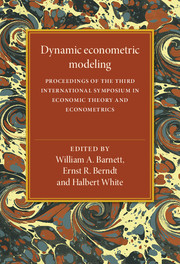 Dynamic Econometric Modeling
Dynamic Econometric Modeling Book contents
- Frontmatter
- Contents
- Editors' introduction
- List of contributors
- Part I Dynamic structural modeling
- Part II Linear time series modeling
- Part III Chaotic attractor modeling
- 11 The aggregation-theoretic monetary aggregates are chaotic and have strange attractors: an econometric application of mathematical chaos
- 12 Theorems on distinguishing deterministic from random systems
- Part IV Applications
11 - The aggregation-theoretic monetary aggregates are chaotic and have strange attractors: an econometric application of mathematical chaos
Published online by Cambridge University Press: 03 May 2010
- Frontmatter
- Contents
- Editors' introduction
- List of contributors
- Part I Dynamic structural modeling
- Part II Linear time series modeling
- Part III Chaotic attractor modeling
- 11 The aggregation-theoretic monetary aggregates are chaotic and have strange attractors: an econometric application of mathematical chaos
- 12 Theorems on distinguishing deterministic from random systems
- Part IV Applications
Summary
Introduction
A major methodological revolution is going on in the physical sciences at the present time as a result of dramatic recent advances in nonlinear dynamics. During the past 10 years, the mathematics and physics literature on strange attractors, bifurcation theory, and deterministic chaos have acquired growing capabilities in many fields. Most of the major advances in these areas were produced through numerical iteration on nonlinear deterministic dynamical recursions and required the use of computers. Computing power is especially important in the continuous–time applications. Hence, the fact that most such advances occurred within the past 10 years is not surprising. Examples of the recent accomplishments of that literature include the production of deterministic explanations for brain wave behavior, memory retrieval, turbulence in fluids, insect population behavior, thermal convection dynamics, climatic behavior over centuries of data, chemically reacting systems, buckling beams, sunspot activity, nonlinear wave interactions in plasmas, solid–state physics, lasers, selfgeneration of the earth's magnetic field, magnetohydrodynamic flow, andmany other such phenomena that previously had been viewed as inherently stochastic and beyond existing theoretical modeling capabilities. The applications have been both theoretical and empirical. Although the first definitive experimental observations of deterministic chaos in nature were produced by physicists only 3 years ago (in a number of papers published in 1983), it nevertheless already has become clear that low–dimensional chaos is common in nature.
- Type
- Chapter
- Information
- Dynamic Econometric ModelingProceedings of the Third International Symposium in Economic Theory and Econometrics, pp. 199 - 246Publisher: Cambridge University PressPrint publication year: 1988
- 48
- Cited by
